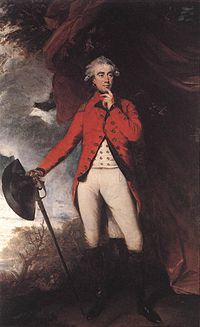Marquess of Hastings

Marquess of Hastings was a title in the Peerage of the United Kingdom. It was created on 6 December 1816 for Francis Rawdon-Hastings, 2nd Earl of Moira.
History
The Rawdon family descended from Francis Rawdon (d. 1668), of Rawdon, Yorkshire. His son Sir George Rawdon, 1st Baronet settled in the village of Moira, County Down. His son, the second Baronet, and grandson, the third Baronet, both represented County Down in the Irish House of Commons. The latter was succeeded by his son, Sir John Rawdon, 4th Baronet. He was created Baron Rawdon, of Moira in the County of Down, in 1750, and Earl of Moira in 1762. Both titles were in the Peerage of Ireland. Lord Moira married as his third wife Elizabeth Hastings, 12th Baroness Hastings, 16th Baroness Botreaux, 11th Baroness Hungerford and 10th Baroness de Moleyns, daughter of Theophilus Hastings, 9th Earl of Huntingdon. Their son Francis Rawdon was a prominent soldier and colonial administrator. He was created Baron Rawdon, of Rawdon, in the County of York, in his own right in the Peerage of Great Britain in 1783, ten years before inheriting the earldom from his father.[1] He assumed the additional surname of Hastings in 1789 in accordance with the will of his uncle Francis Hastings, 10th Earl of Huntingdon. In 1808 he succeeded his mother in the baronies of Hastings, Botreaux, Hungerford and de Moleyns. In 1816 he was created Viscount Loudoun, Earl of Rawdon and Marquess of Hastings in the Peerage of the United Kingdom.[2] Lord Hastings married Flora Mure-Campbell, 6th Countess of Loudoun.
He was succeeded by his eldest son, the second Marquess. In 1840 he also succeeded his mother in the earldom of Loudoun. Lord Hastings married Barbara Yelverton, 20th Baroness Grey de Ruthyn. He was succeeded by his eldest son, the third Marquess. He died aged only seventeen and was succeeded by his younger brother, the fourth Marquess. In 1858 he also succeeded his mother as 21st Baron Grey de Ruthyn. Lord Hastings died childless in 1868. On his death the baronetcy of Moira, baronies of Rawdon, vicountcy of Loudoun, earldoms of Moira and Rawdon and marquessate of Hastings became extinct. The Scottish earldom of Loudoun was passed on to his eldest sister Edith Rawdon-Hastings, 10th Countess of Loudoun (see Earl of Loudoun for further history of this title). The baronies of Botreaux, Hungerford, de Moleyns, Hastings and Grey de Ruthyn fell into abeyance between his sisters. The baronies of Botreaux, Hastings of Hungerford, de Moleyns, Hastings were called out of abeyance in 1871 in favour of Lord Hastings's eldest sister, the aforementioned Edith Rawdon-Hastings, 10th Countess of Loudoun, while the barony of Grey de Ruthyn was called out of abeyance the same year in favour of his second sister Bertha, 22nd Baroness Grey de Ruthyn (see the Baron Grey de Ruthyn for further history of this title).
Rawdon Baronets, of Moira (1665)
- Sir George Rawdon, 1st Baronet (1604–1684)
- Sir Arthur Rawdon, 2nd Baronet (1662–1695)
- Sir John Rawdon, 3rd Baronet (1690–1724)
- Sir John Rawdon, 4th Baronet (created Baron Rawdon in 1750 and Earl of Moira in 1762)
Earls of Moira (1762)
- John Rawdon, 1st Earl of Moira (1720–1793)
- Francis Rawdon-Hastings, 2nd Earl of Moira (created Marquess of Hastings in 1816)
Marquesses of Hastings (1816)
- Francis Rawdon-Hastings, 1st Marquess of Hastings (1754–1826)
- George Augustus Francis Rawdon-Hastings, 2nd Marquess of Hastings (1808–1844)
- Paulyn Reginald Serlo Rawdon-Hastings, 3rd Marquess of Hastings (1832–1851)
- Henry Weysford Charles Plantagenet Rawdon-Hastings, 4th Marquess of Hastings (1842–1868)
References
- ^ "No. 12419". The London Gazette. 1 March 1783.
- ^ "No. 17198". The London Gazette. 7 December 1816.
